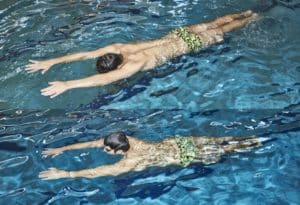Body, Line and Posture. The KEY to avoiding sinking legs

So many athletes come to me complaining of how swimming is really hard work for them. A large number of triathletes complain about sinking legs – unless they are swimming in a wetsuit. The thing with triathletes is that they have a tendancy to have very dense legs, a lot of muscle from cycling and running. Muscle weighs more than water so yes it will encourage the legs lower in the water. However there is a lot you can do to prevent this from causing any issues.
Not only will this help swimmers who feel their legs drag along the pool floor, but for a large number of swimmers will help to reduce resistance to the water – making life easier and hopefully you faster!
Why Do It:
Posture, line and balance are the key to swimming easier and/or faster. This involves working those core muscles that we hear so much about – and possibly do some work on!
By doing the dead man float, and feeling the hips rise toward the surface (and possibly the legs as well, at least in part), the intention is that you will feel how you don’t have to fight the water, that you can really feel that everything you then do is propelling you forward through the water rather than keeping you afloat.
It also shows you how head position makes a massive difference to body position!
How To Do It:
1. Let everything relax, with a full lung of air, float face down in the water. You’ll probably feel like a hunchback with your legs hanging down.
2. Set your core (pull belly button up toward your spine, squeeze your glutes – imagine that you have a £50 note between your cheeks) and look toward the bottom of the pool.
3. Slowly lift your arms up from hanging loose toward the surface of the water above your head.
4. Kick your legs very gently until you need a breath.
How to Do It Really Well (the Fine Points):
The idea is that by pulling your core in and looking down, your back will flatten out. By lifting your arms up into a streamlined position, your legs will start to rise toward the surface as well. For a large percentage of people, legs might not reach the top levels of the water, but with a little bit of kick to provide momentum everything should pop right up.
All of this points to why we do core work and what its benefits are to you. A lot of medical professionals will tell injured athletes that they need to work on their core – but not how to then use it. A large number of coaches will say the same. Its all very well and good being able to hold a plank for 5minutes or more, but if you can’t use it to stand up straight and tall then its of no use to you. Similarly posture is key to everything you do. If your posture is poor while driving or at your work desk, you get back/neck problems. If you run with poor posture, then you’re more susceptible to back/hip/knee issues. Cycling with poor posture hurts your back, makes you less powerful. And swimming with poor posture (head/eyes up and forward, curved back) creates extra resistance for you, making life harder.

See how the head position affects the depth of the legsBeing able to control your core and posture will make you smoother, stronger and faster in the water. And if you are a triathlete, being stronger and more efficient in the water means more energy to bike and run better.
See what’s up next week for our #SwimTechTues tip! For more in depth understanding on how to put this into practise, get in touch and we’ll see how we can help!
